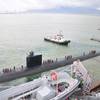World seaborne trade rebounded in 2002 to 5.89 billion tons, exceeding the previous record set in 2000, reports UNCTAD´s Review of Maritime Transport 2003, released recently. The recovery in seaborne trade reflects the improved growth in world output and is expected to continue this year, amidst concern about the increased costs involved in implementing tougher security measures. The measures, which are being taken by the United States and by the International Maritime Organization (IMO), could also result in reduced cargo theft and faster cargo clearance. Because of expertise, equipment and other resources entailed in implementation, they might prove difficult for the poorer countries to comply with.
The annual UNCTAD report looks at developments in world maritime transport, particularly for developing countries, and this year focuses on Africa. Last year´s tonnage represented a significant increase over the 2001 slump - 5.84 billion tons - and a minor increase over the 5.87 billion tons recorded for 2000.
Asian countries, including Japan, had the largest share of the total volume of seaborne world exports (37%), a figure that was relatively unchanged from 2001. Manufactured goods from East and South-East Asia, together with large crude oil exports from Western Asia, contributed to this result. Countries in Europe accounted for 25.4% of world volume loaded, with EU members representing 70% of the overall European share. Industrialized countries in North America and developing countries in America made up 21.2% of world export volume; the latter countries´ sizeable exports of crude oil, iron ore, coal and grains accounted for about two thirds of the total volume for the hemisphere. The shares of Africa and Oceania in world volume exported were 8.8% and 7.6%, respectively.
The decline in seaborne crude oil trade depressed tanker freight rates for most of the year, according to the Review. Average freight indices for the several types of tankers fell tumbled over 30%, making 2002 another bad year for tanker owners, with the downward trend continuing into early 2003. Conversely, the increase in dry bulk trades benefited rates for all sectors and sizes of dry bulk carriers: the rates for some time charters soared by over 150% during the course of the year. For the containership markets, rates generally increased but did not recover to those prevailing at the beginning of 2001. The Asia-Europe route improved the most, with rates up by around 20% in each direction last year, attributable to growing trade between the two regions. Rates have continued to climb this year, and by mid-2003 carriers had ordered more than 60 vessels with a capacity of 8,000 TEUs (20-foot equivalent units). Further concentration occurred in containerized liner shipping: the top 10 carriers now control almost 44% of the world´s total container carrying capacity.
Featured videos

Inmarsat Enhances Service to Drive Digitalization

Inside the Electrified Truckable Tug

Tracking Foreign Vessels Working in the U.S. Jones Act Market
Subscribe for
Maritime Reporter E-News
Maritime Reporter E-News is the maritime industry's largest circulation and most authoritative ENews Service, delivered to your Email five times per week









